Mushrooms, specifically tree mushrooms, play a critical role in forest ecosystems, contributing to nutrient cycling, decomposition, and biodiversity. Tree mushrooms, also known as “saprobes” or “decay fungi,” grow on living or dead trees and have evolved complex relationships with their environment. They are an essential component of the ecological health of forests, aiding in the breakdown of organic matter and serving as a food source and habitat for many organisms.
In this article, we will explore the environmental niche of tree mushrooms, their ecological significance, different types of tree mushrooms, their role in forest ecosystems, their relationships with trees, and the importance of conserving these fungi for maintaining forest health.
1. Tree Mushrooms and Their Environmental Niche
Tree mushrooms occupy a specific niche in the environment where they decompose wood and organic matter, playing a pivotal role in the nutrient cycles of forests. Their ability to break down complex organic compounds such as lignin and cellulose makes them vital to the health and productivity of forest ecosystems. The term “tree mushrooms” includes a variety of fungal species that grow on or near trees, whether living or dead, and thrive in a range of conditions, from temperate forests to tropical rainforests.

1.1. Decomposers and Saprotrophs: Nature’s Recyclers
Tree mushrooms are often classified as saprotrophs, meaning they derive nutrients by breaking down dead organic material. In forest ecosystems, this function is crucial for nutrient recycling, as it allows dead trees and plant matter to decompose and return vital nutrients to the soil, fostering new plant growth.
- Nutrient Recycling: By breaking down lignin and cellulose in wood, tree mushrooms convert organic matter into simpler forms that can be absorbed by other organisms, such as plants. This process not only prevents the buildup of dead wood in forests but also ensures the continued availability of essential nutrients like nitrogen and phosphorus.
- Energy Flow: Tree mushrooms are at the center of the energy flow in forest ecosystems. As primary decomposers, they facilitate the transfer of energy from dead trees to other organisms in the food web, including insects, small mammals, and other fungi.
1.2. Symbiotic Relationships: Mycorrhizae and Mutualism
Not all tree mushrooms are decomposers; some form symbiotic relationships with living trees. Mycorrhizal fungi, for example, form mutualistic associations with the roots of trees, exchanging nutrients and providing benefits to both the tree and the fungus.
- Mycorrhizal Fungi: These fungi colonize tree roots and extend their hyphal networks far into the soil, increasing the tree’s access to water and nutrients like phosphorus. In return, the tree provides the fungi with carbohydrates produced through photosynthesis. This relationship enhances the health and resilience of trees, particularly in nutrient-poor soils.
- Endophytes: Some tree mushrooms live inside the bark or tissues of trees without causing harm, a relationship known as endophytism. These fungi may help protect the tree from pathogens or assist with water retention, demonstrating another important role of tree mushrooms in forest ecosystems.
1.3. Types of Tree Mushrooms
Tree mushrooms come in a variety of forms, each adapted to specific environmental conditions and tree species. Some of the most common types include bracket fungi, polypores, and shelf mushrooms.
- Bracket Fungi: These are among the most recognizable tree mushrooms, often forming hard, shelf-like structures on tree trunks. Species like the Artist’s Conk (Ganoderma applanatum) are examples of bracket fungi that decompose dead wood and play a key role in the forest’s nutrient cycles.
- Polypores: Polypores are a group of fungi that grow on trees, characterized by their porous undersides. The Turkey Tail (Trametes versicolor) is one of the most well-known polypores, often found on dead or decaying trees. These fungi help break down wood and release nutrients into the ecosystem.
- Shelf Mushrooms: Similar to bracket fungi, shelf mushrooms grow horizontally out of tree trunks or branches. These fungi can grow in layers and are often tough and woody in texture, serving as both decomposers and habitats for small organisms.
2. The Role of Tree Mushrooms in Forest Ecosystems
Tree mushrooms play a variety of roles in forest ecosystems, ranging from decomposition and nutrient cycling to providing habitats and food for wildlife. They are integral to forest health, and their presence indicates a balanced and functioning ecosystem.
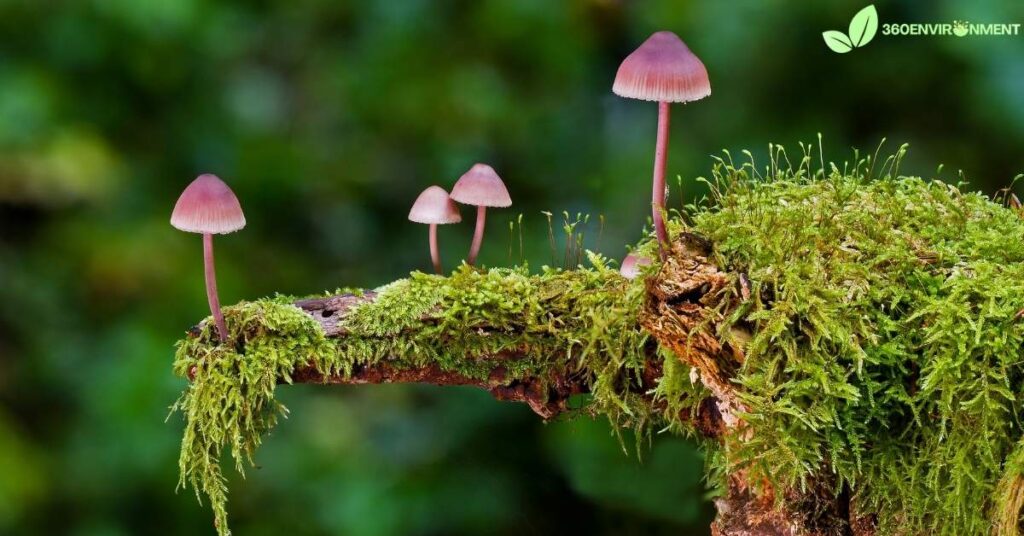
2.1. Decomposition and Nutrient Cycling
The primary role of tree mushrooms in forest ecosystems is their role as decomposers. They break down the complex organic materials found in dead trees, returning these materials to the soil and making nutrients available to other plants and organisms.
- Wood Decay: Tree mushrooms, particularly those that grow on dead or dying trees, are essential for breaking down lignin, the tough, fibrous material in wood. Without tree mushrooms, dead trees would take much longer to decompose, leading to a buildup of organic matter and slowing down nutrient cycling in the forest.
- Soil Fertility: As tree mushrooms decompose wood, they contribute to the formation of humus, a nutrient-rich organic layer in the soil. This humus is critical for plant growth, as it retains moisture and provides a steady supply of nutrients to plants, fungi, and other organisms in the forest.
2.2. Habitat and Food for Wildlife
In addition to their role as decomposers, tree mushrooms provide essential habitat and food for a variety of forest creatures, from insects to mammals. Their presence in the forest ecosystem supports biodiversity and creates microhabitats for various organisms.
- Habitat for Insects: Many insects, such as beetles and ants, rely on tree mushrooms for shelter and food. The decaying wood and fruiting bodies of tree mushrooms provide the perfect environment for insect larvae to grow and develop. In turn, these insects serve as food for birds and other forest predators.
- Food Source for Mammals and Birds: Tree mushrooms are a valuable food source for forest animals, including deer, squirrels, and woodpeckers. Certain mushrooms, such as the Chicken of the Woods (Laetiporus sulphureus), are especially palatable and nutritious for wildlife. Additionally, the spores released by tree mushrooms are consumed by a variety of organisms, further supporting the forest’s food web.
2.3. Supporting Forest Structure and Resilience
Tree mushrooms play an indirect role in maintaining the structural integrity and resilience of forest ecosystems. By breaking down dead trees and other organic matter, they create space for new growth and prevent the accumulation of potential fire hazards.
- Forest Floor Management: As tree mushrooms break down dead wood, they help clear the forest floor of debris. This process reduces the risk of forest fires by limiting the amount of dry, flammable material on the ground. Additionally, the decomposition of trees creates gaps in the canopy, allowing sunlight to reach the forest floor and promoting the growth of new plants.
- Ecosystem Resilience: By maintaining the nutrient cycles and structural balance of forest ecosystems, tree mushrooms contribute to the overall resilience of forests. Healthy forests are better able to recover from disturbances such as fires, storms, and pest infestations, thanks in part to the work of tree mushrooms in sustaining biodiversity and nutrient availability.
3. Symbiotic Relationships Between Tree Mushrooms and Trees
Tree mushrooms are involved in complex relationships with the trees they inhabit, ranging from parasitic to mutualistic. These relationships are a fundamental aspect of forest ecology, influencing tree health, growth, and survival.
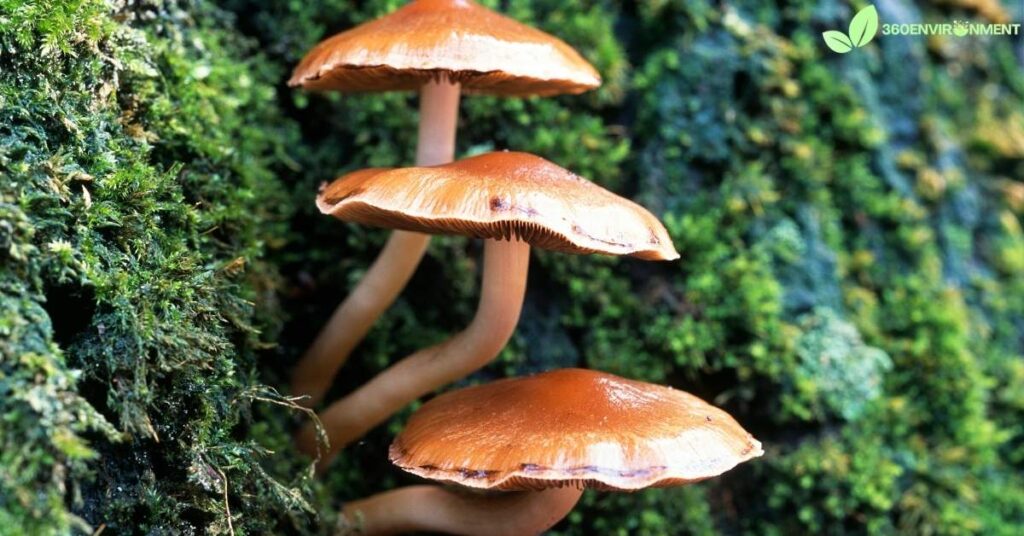
3.1. Parasitic Fungi: The Role of Pathogens
While many tree mushrooms act as decomposers or mutualists, some are parasitic, infecting living trees and causing diseases. These parasitic fungi play a natural role in the life cycle of forests by thinning out weaker trees and creating opportunities for new growth.
- Heart Rot Fungi: Some tree mushrooms, such as Honey Fungus (Armillaria spp.), cause diseases like root rot or heart rot, which weaken and eventually kill the host tree. These fungi invade the inner wood of the tree, breaking down its structure from the inside. While this may seem harmful, it is part of the natural cycle of forest succession, as the death of older trees makes way for younger, healthier trees to grow.
- Forest Dynamics: Parasitic fungi help regulate tree populations by targeting older or weakened individuals, which might otherwise compete for resources with younger trees. This process of natural selection ensures that forests remain dynamic and diverse, with a constant turnover of trees.
3.2. Mutualistic Fungi: Mycorrhizal Networks
One of the most important mutualistic relationships between tree mushrooms and trees is the formation of mycorrhizal networks. These symbiotic partnerships benefit both the fungi and the trees, contributing to forest health and productivity.
- Nutrient Exchange: In mycorrhizal associations, the fungal mycelium extends into the soil, dramatically increasing the surface area available for nutrient and water absorption. The fungi extract nutrients such as phosphorus and nitrogen from the soil and transfer them to the tree’s roots. In exchange, the tree provides the fungi with carbohydrates, produced through photosynthesis, to fuel their growth.
- Communication and Defense: Mycorrhizal networks also serve as communication pathways between trees. Through these underground fungal networks, trees can exchange chemical signals, warning each other about insect infestations or environmental stressors. This “wood wide web” enhances the collective resilience of the forest ecosystem.
4. Types of Tree Mushrooms: Common Species and Their Roles
There are thousands of species of tree mushrooms, each playing unique roles in their respective ecosystems. Below are some of the most common types of tree mushrooms, along with their ecological functions.
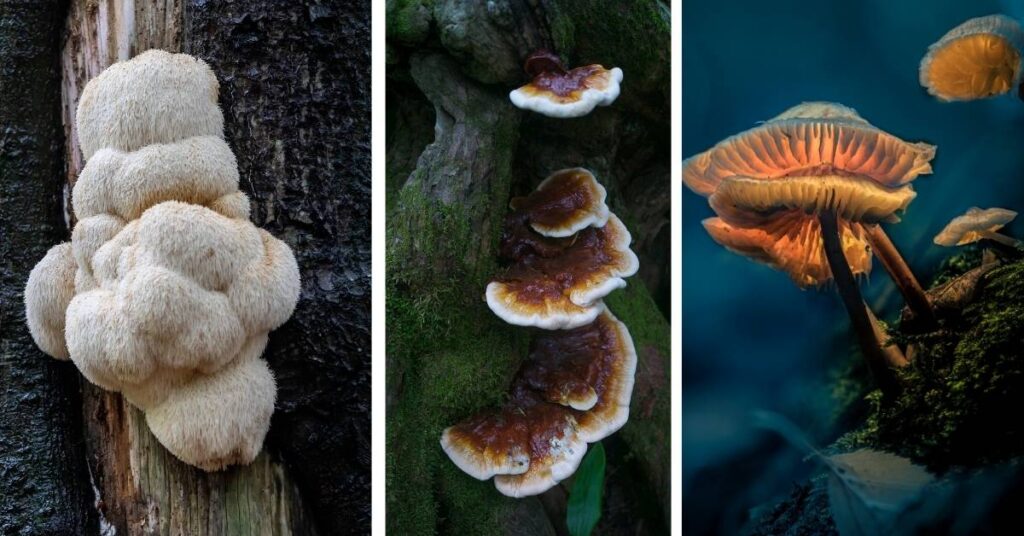
4.1. Turkey Tail (Trametes versicolor)
Turkey tail is one of the most recognizable tree mushrooms, named for its distinct fan-shaped, multicolored caps that resemble a turkey’s tail. It is a polypore fungus commonly found on decaying hardwood trees.
- Ecological Role: Turkey tail is a saprophytic fungus, meaning it helps decompose dead wood and recycle nutrients back into the forest ecosystem. It is especially important in temperate forests, where it plays a key role in breaking down lignin, a complex polymer in wood.
- Medicinal Uses: In addition to its ecological role, Turkey tail has been used in traditional medicine for its purported immune-boosting properties. Some modern research has explored its potential use in cancer treatment and immune support, further highlighting the importance of fungi in both ecological and human health contexts.
4.2. Artist’s Conk (Ganoderma applanatum)
The Artist’s Conk is a large, perennial tree mushroom known for its hard, shelf-like fruiting body. Its name comes from the smooth, white underside of the mushroom, which darkens when scratched, allowing people to etch designs into it.
- Ecological Role: Artist’s Conk is a decomposer that primarily grows on dead or decaying hardwoods, where it helps break down lignin and cellulose. Its ability to decompose wood over many years makes it a key player in nutrient cycling in forest ecosystems.
- Art and Culture: Aside from its role in decomposition, the Artist’s Conk has cultural significance, as its durable surface has been used for centuries as a medium for artistic expression. This cultural connection highlights the diverse ways in which humans interact with tree mushrooms.
4.3. Chicken of the Woods (Laetiporus sulphureus)
Chicken of the Woods is a bright orange-yellow mushroom that grows in large, shelf-like clusters on dead or dying trees. Its name comes from its texture, which is said to resemble chicken meat.
- Ecological Role: Chicken of the Woods is a saprobic fungus, meaning it plays a crucial role in breaking down dead wood. It helps decompose both hardwood and softwood trees, particularly oak and chestnut, contributing to the recycling of organic material in the forest.
- Edibility: This mushroom is not only important ecologically but also highly prized as an edible species. It is one of the most sought-after wild mushrooms for foraging, adding a culinary dimension to its environmental importance.
5. Conservation of Tree Mushrooms: Threats and Protection
Despite their importance in forest ecosystems, tree mushrooms face several threats due to human activities, including habitat destruction, pollution, and climate change. Conservation efforts are necessary to protect these vital organisms and ensure the health of forest ecosystems.
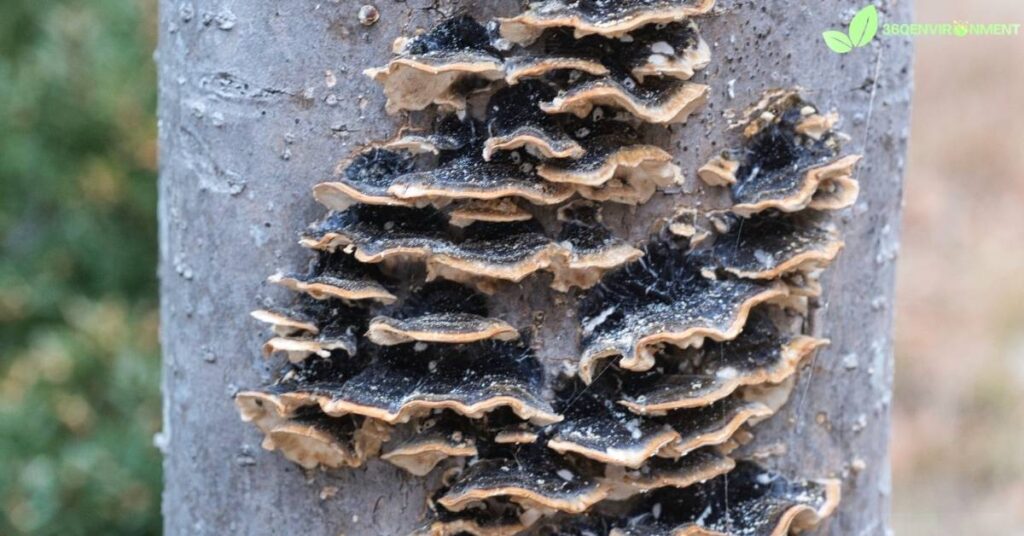
5.1. Habitat Destruction and Deforestation
One of the greatest threats to tree mushrooms is the destruction of their habitats through deforestation and land-use change. As forests are cleared for agriculture, urban development, or logging, the fungi that rely on trees and decaying wood lose their primary habitat.
- Impact on Biodiversity: The loss of tree mushrooms due to deforestation can have far-reaching effects on forest biodiversity. These fungi support a wide range of organisms, and their disappearance can lead to a cascade of negative effects on the entire ecosystem.
- Forest Fragmentation: Even in areas where forests are not completely cleared, fragmentation can disrupt the mycorrhizal networks that connect trees and fungi. This fragmentation can reduce the ability of fungi to form symbiotic relationships with trees, weakening forest resilience.
5.2. Pollution and Environmental Contamination
Pollution, particularly air and soil pollution, can negatively impact tree mushrooms. Heavy metals, pesticides, and other contaminants can inhibit fungal growth or even kill existing colonies.
- Acid Rain: Acid rain, caused by industrial emissions of sulfur dioxide and nitrogen oxides, can alter the pH of forest soils, making them less hospitable for fungi. Acidic conditions can inhibit the ability of tree mushrooms to decompose organic matter and form symbiotic relationships with trees.
- Pesticide Use: The use of pesticides and herbicides in forestry and agriculture can also harm tree mushrooms. These chemicals can disrupt the delicate balance of soil microbiota, reducing fungal diversity and impacting their ecological functions.
5.3. Climate Change and Its Impact on Fungal Growth
Climate change poses a long-term threat to tree mushrooms, as rising temperatures, altered precipitation patterns, and shifting ecosystems affect fungal growth and reproduction. Tree mushrooms are particularly sensitive to changes in humidity and temperature, which can impact their ability to decompose wood and form fruiting bodies.
- Shifts in Fungal Distribution: As climate change alters the conditions of forest ecosystems, tree mushrooms may shift their geographic ranges. Some species may move to higher elevations or latitudes in search of cooler, moister environments, while others may struggle to adapt to changing conditions.
- Impact on Mycorrhizal Fungi: Mycorrhizal fungi, in particular, may be affected by climate change, as changes in temperature and precipitation can disrupt the symbiotic relationships between fungi and trees. This disruption could weaken forest ecosystems, making them more vulnerable to stressors such as drought and disease.
6. Importance of Tree Mushroom Conservation
The conservation of tree mushrooms is essential for maintaining the health and stability of forest ecosystems. Protecting these fungi ensures the continued recycling of nutrients, supports biodiversity, and enhances the resilience of forests to environmental changes.
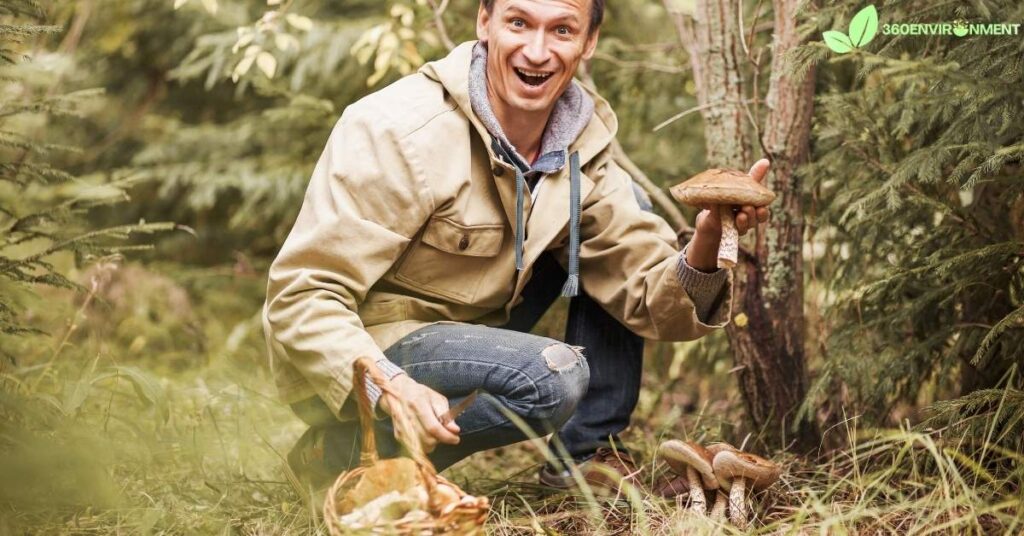
6.1. Protecting Forest Habitats
Efforts to conserve tree mushrooms must focus on protecting and restoring forest habitats. This includes preventing deforestation, promoting sustainable forestry practices, and establishing protected areas where tree mushrooms can thrive.
- Sustainable Forestry: Implementing sustainable forestry practices, such as selective logging and maintaining dead wood in forests, can help preserve the habitat for tree mushrooms. Dead wood provides the substrate for many tree mushrooms, and its presence is crucial for supporting fungal biodiversity.
- Protected Areas: Establishing protected areas, such as national parks and forest reserves, can safeguard the habitats of tree mushrooms from human disturbance. These areas provide a refuge for fungi and other organisms, allowing ecosystems to function naturally and without interference.
6.2. Promoting Public Awareness and Research
Raising public awareness about the importance of tree mushrooms and their role in ecosystems is crucial for their conservation. Additionally, continued research into fungal ecology and the impacts of environmental change on fungi will help guide conservation efforts.
- Education and Outreach: Public education campaigns that highlight the ecological role of tree mushrooms can foster greater appreciation for these organisms and encourage conservation efforts. Citizen science projects, such as fungal forays and mushroom identification workshops, can engage the public in monitoring and protecting fungi.
- Research and Monitoring: Ongoing research into the ecology of tree mushrooms is essential for understanding their responses to environmental changes and threats. Long-term monitoring programs can track changes in fungal populations and provide data for conservation strategies.
Conclusion: The Critical Role of Tree Mushrooms in Forest Ecosystems
Tree mushrooms are an integral part of forest ecosystems, contributing to decomposition, nutrient cycling, and biodiversity. Their ability to break down wood and organic matter supports the health of forests and provides food and habitat for a variety of organisms. Additionally, their symbiotic relationships with trees enhance the resilience of forests, helping them withstand environmental stressors and disturbances.
However, tree mushrooms face numerous threats from habitat destruction, pollution, and climate change. Protecting these fungi through habitat conservation, sustainable forestry, and public awareness is essential for maintaining the ecological balance of forests and ensuring their continued health and productivity. By recognizing the importance of tree mushrooms and taking action to conserve them, we can help safeguard the future of forest ecosystems and the countless species that depend on them.
Read More: Porphyrellus indecisus: Understanding the Environmental Niche of the Indecisive Bolete

